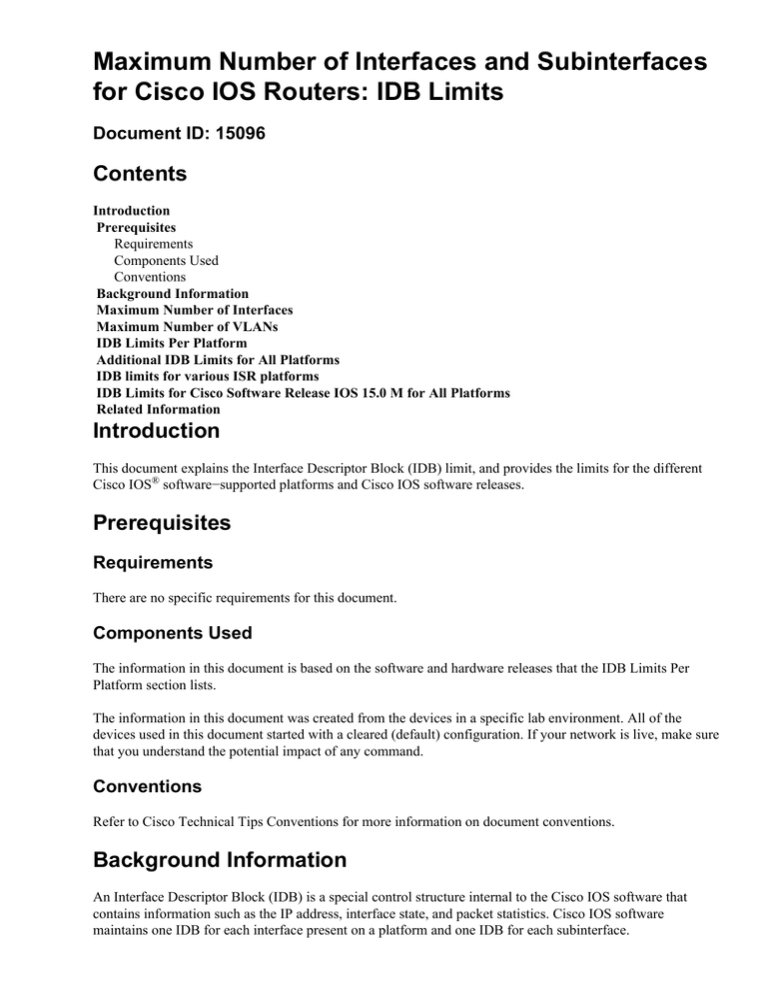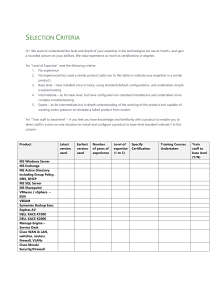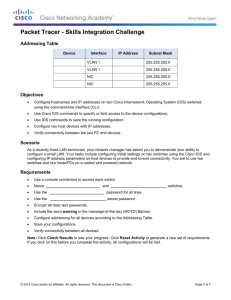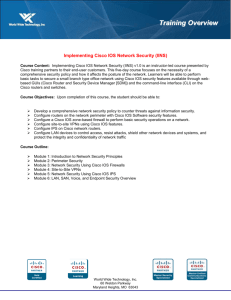
Maximum Number of Interfaces and Subinterfaces
for Cisco IOS Routers: IDB Limits
Document ID: 15096
Contents
Introduction
Prerequisites
Requirements
Components Used
Conventions
Background Information
Maximum Number of Interfaces
Maximum Number of VLANs
IDB Limits Per Platform
Additional IDB Limits for All Platforms
IDB limits for various ISR platforms
IDB Limits for Cisco Software Release IOS 15.0 M for All Platforms
Related Information
Introduction
This document explains the Interface Descriptor Block (IDB) limit, and provides the limits for the different
Cisco IOS® software−supported platforms and Cisco IOS software releases.
Prerequisites
Requirements
There are no specific requirements for this document.
Components Used
The information in this document is based on the software and hardware releases that the IDB Limits Per
Platform section lists.
The information in this document was created from the devices in a specific lab environment. All of the
devices used in this document started with a cleared (default) configuration. If your network is live, make sure
that you understand the potential impact of any command.
Conventions
Refer to Cisco Technical Tips Conventions for more information on document conventions.
Background Information
An Interface Descriptor Block (IDB) is a special control structure internal to the Cisco IOS software that
contains information such as the IP address, interface state, and packet statistics. Cisco IOS software
maintains one IDB for each interface present on a platform and one IDB for each subinterface.
There are two main types of IDBs:
• Hardware IDBs (HWIDBs)
• Software IDBs (SWIDBs)
A HWIDB represents a physical interface, which includes physical ports and channelized interface
definitions. A SWIDB represents a logical sub−interface (Permanent Virtual Circuit (PVC) or virtual LAN
(VLAN)), or a Layer 2 encapsulation (Point−to−Point Protocol (PPP), High−Level Data Link Control
(HDLC), and so forth).
Each physical interface on the router consumes a minimum of two IDBs:
• One HWIDB for the physical port
• One SWIDB for the Layer 2 encapsulation
A channelized port consumes N+1 HWIDBs, where N is the number of channels within the physical port, plus
a minimum of N SWIDBs (Level 2 encapsulation per channel). Any sub−interfaces that you define each add
another SWIDB.
Each tunnel interface definition, such as Universal Transport Interface (UTI), Generic Routing Encapsulation
(GRE), Multiprotocol Label Switching Traffic Engineering (MPLS TE), or Any Transport over MPLS
(AToM) consumes an HWIDB plus one SWIDB per tunnel, plus an additional SWIDB for each additional
sub−interface, for example, a Frame Relay PVC, that is tunneled. The tunnel IDBs are in addition to the
original interface(s) that are tunneled.
Layer 2 Tunnel Protocol Version 3 (L2TPv3), which replaces UTI in Cisco IOS Software Release 12.0(23)S,
does not consume IDBs, because L2TPv3 is a session−based pseudo−wire implementation rather than a
defined tunnel interface such as UTI.
The maximum number of interfaces (physical, subinterface, or virtual) a router can handle depends on the
maximum number of SWIDBs that the router can use. This limit used to be set to 300 for all platforms, but
with the emergence of features such as frame−relay subinterfaces, multilink Point−to−Point Protocol (PPP),
and virtual private dial−up network (VPDN) that uses virtual interfaces, this value has proven to be
insufficient on some platforms.
Cisco has performed extensive work to scale Cisco IOS software to these new requirements. From Cisco IOS
Software Release 11.3T and later, the IDB limit depends on the platform and the Cisco IOS software release.
The IDB limit now indicates the maximum number of interfaces a router can handle, if you assume that other
resources, such as memory, CPU, and so forth, are available.
In order to see the maximum number of IDBs, and the number of IDBs currently in use, along with their
memory consumption, use the show idb IOS command. This command is available in Cisco IOS Software
Releases 12.1(9), 12.1(9)E, 12.1(9)EC, 12.0(18)S/ST, 12.2(x), 12.2(x)T, and 12.2(2)B.
If you monitor the number of IDBs currently in use, you can re−configure or add capacity as the IDB limit is
approached for dial and aggregation purposes.
The output of the show idb command looks similar to this:
Router#show idb
Maximum number of IDBs 4096
42 SW IDBs allocated (2440 bytes each)
40 HW IDBs allocated (5760 bytes each)
HWIDB#1
1
SRP0/0 (HW IFINDEX, SRP)
HWIDB#2
2
POS1/0 (HW IFINDEX, SONET, Serial)
HWIDB#3
7
FastEthernet3/0 (HW IFINDEX, Ether)
HWIDB#4
8
FastEthernet3/1 (HW IFINDEX, Ether)
HWIDB#5
9
FastEthernet3/2 (HW IFINDEX, Ether)
HWIDB#6
10 FastEthernet3/3 (HW IFINDEX, Ether)
HWIDB#7
11 FastEthernet3/4 (HW IFINDEX, Ether)
HWIDB#8
12 FastEthernet3/5 (HW IFINDEX, Ether)
HWIDB#9
13 FastEthernet3/6 (HW IFINDEX, Ether)
HWIDB#10 14 FastEthernet3/7 (HW IFINDEX, Ether)
HWIDB#11 15 POS4/0 (HW IFINDEX, SONET, Serial)
HWIDB#12 16 POS4/1 (HW IFINDEX, SONET, Serial)
HWIDB#13 17 POS4/2 (HW IFINDEX, SONET, Serial)
HWIDB#14 18 POS4/3 (HW IFINDEX, SONET, Serial)
HWIDB#15 19 GigabitEthernet6/0 (HW IFINDEX, Ether)
HWIDB#16 21 POS10/0 (HW IFINDEX, SONET, Serial)
HWIDB#17 22 POS11/0 (HW IFINDEX, SONET, Serial)
HWIDB#18 23 Loopback0 (HW IFINDEX)
HWIDB#19 24 Loopback1 (HW IFINDEX)
HWIDB#20 25 Tunnel100 (HW IFINDEX)
HWIDB#21 26 Tunnel909 (HW IFINDEX)
HWIDB#22 27 Ethernet0 (HW IFINDEX, Ether)
Maximum Number of Interfaces
Every interface uses an IDB. Therefore, the IDB limit indicates the maximum number of interfaces a router
can handle.
The IDB limit is, therefore, the answer to the common question "How many (sub)interfaces can be configured
on this platform?"
Maximum Number of VLANs
Each Virtual LAN (VLAN) requires one IDB. Any Cisco IOS software release can support up to 4096
VLANs (0−4095, where the number range is 1 to 4094 and in which 0, 4095 are reserved), if the platform
supports at least 4000 IDBs
There is a limitation of 256 bridge groups in the Cisco IOS software release if you use VLAN bridging.
IDB Limits Per Platform
Table 1 lists the IDB limit for the different Cisco IOS software−supported platforms and Cisco IOS Software
Releases 11.3T and later:
Platform/IOS Cisco IOS Software Release 11.3T Cisco IOS Software Release 11.3AA Cisco IOS
Software Release 12.0 Cisco IOS Software Release 12.0S Cisco IOS Software Release 12.0T Cisco IOS
Software Release 12.1 Cisco IOS Software Release 12.1T Cisco IOS Software Release 12.2 Cisco IOS
Software Release 12.2T Cisco IOS Software Release 12.3 Cisco IOS Software Release 12.3T as5200 300
300 300 n/a 300 300 300 300 300 n/a n/a as5300 700 700 700 n/a 800 800 800 800 800 800 800 as5400 n/a
n/a n/a n/a n/a n/a 2000 3000 3000 3000 3000 as5800 n/a 2048 2048 n/a 2048 2048 2048 2048 2048 2048
2048 800 n/a n/a n/a n/a 300 300 300 300 300 300 300 ubr900 n/a n/a n/a n/a 300 300 300 300 300 300 300
1000 300 300 300 n/a 300 300 300 300 300 n/a n/a 1700/c1600 300 300 n/a n/a 300 300 300 300 300 300 300
2500 300 300 300 n/a 300 300 300 300 300 300 300 2600/2600XM 300 300 300 n/a 300 300 300 300 800
800 800 3600 800 800 800 n/a 800 800 800 800 800 800 800 3660 n/a n/a n/a n/a 1400 1400 1400 1400 1400
1400 1400 3725 n/a n/a n/a n/a n/a n/a n/a n/a 800 800 800 3745 n/a n/a n/a n/a n/a n/a n/a n/a 1400 1400
1400 3800 300 300 300 n/a 300 300 300 300 300 n/a n/a mc3810 n/a n/a 300 n/a 300 300 300 300 300 300
300 4000 300 300 300 n/a 300 300 300 300 300 n/a 300 4500/4700 300 300 300 n/a 300 300 300 300 300 300
300 7100 300 300 3000 3000 3000 3000 10000 10000 10000 20000 20000 7200 300 300 3000 3000 3000
3000 10000 10000 10000 20000 20000 MSFC n/a n/a n/a n/a 3000 3000 3000 3000 3000 n/a n/a ls1010 300
300 300 n/a 300 300 300 300 300 n/a n/a 6400 (nrp) n/a n/a n/a n/a 3000 4500 4500 4500 4500 4500 4500
7500 (rsp/vip) 300 1000 1000 2048 2048 2048 2048 2048 2048 2048 2048 12000 (grp/lc) n/a n/a n/a 4096 n/a
n/a n/a n/a n/a n/a n/a
Note:
• Limits in bold denote value changes.
• The numbers in this table are nominal values. Real values might vary. Consult your Cisco Sales
Engineer (SE) for details.
Platform/ IOS Cisco IOS Software Release 12.0.28.S Cisco IOS Software Release 12.2 Cisco IOS
Software Release 12.3(7)X12 ESR 10000 Yes (Can have up to16383) Yes Yes (Can have up to 65530) ESR
10700 Yes (12.0SP) No No
Additional IDB Limits for All Platforms
Table 3 indicates the IDB limit for the different Cisco IOS software−supported platforms and Cisco IOS
software releases (earlier than 11.3T):
Platform/IOS Cisco IOS Software Release 11.3 Cisco IOS Software Release 11.2 Cisco IOS Software
Release 11.2P Cisco IOS Software Release 11.1 Cisco IOS Software Release 11.1CC Cisco IOS Software
Release 11.1CA Cisco IOS Software Release 11.0 All platforms 300 300 300 300 1024 1024 256
IDB limits for various ISR platforms
Platform/IOS Cisco IOS Software Release 12.3T 1841 700 2801 800 2811 800 2821 900 2851 1000 3825
1200 3845 1400
IDB Limits for Cisco Software Release IOS 15.0 M for All
Platforms
Table 5 lists the IDB limit for the Cisco IOS Software Release15.0 M routers. Earlier Cisco IOS software
releases may have the same IDB limits.
Platform/IOS
812, 819, and 860
880 and 890
1800−fixed
1841
1861 and 1861E
1900
2801
2811
IDB limit
300
300
300
1200
300
1200
1200
1400
2821
1400
2851
1400
2901
1200
2911 & 2921
2951
1400
1800
3825 & 3845
3925 & 3945
3925E & 3945E
7200VXR
ASR1000 ESP 2.5
ASR1000 ESP 5
ASR1000 ESP 10
ASR1000 ESP 20
ASR1000 ESP 40
1400
2400
4800
20050
65535 / 16K *
65535 / 32K *
65535 /32K *
65535 / 64K *
65535 / 64K *
Note: *ASR1000 IOS XE allows a maximum of 65535 IDBs. But, the maximum number of supported logical
interfaces is lower and varies by model of ESP in use. For example, in ASR 1000 ESP 2.5, the router uses
ESP 2.5
Related Information
• Cisco IOS Software Releases 12.2 Mainline Product Support Page
• Technical Support & Documentation − Cisco Systems
Contacts & Feedback | Help | Site Map
© 2014 − 2015 Cisco Systems, Inc. All rights reserved. Terms & Conditions | Privacy Statement | Cookie Policy | Trademarks of
Cisco Systems, Inc.
Updated: May 24, 2012
Document ID: 15096





